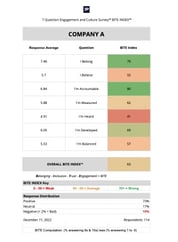When it comes to balance in the workplace, several different explanations are employed to describe what it means, and many of these definitions are correct in one respect or another. In fact, the most complete description of workplace balance incorporates multiple elements from the popular definitions of balance. This ultimately means true employee balance combines considerations of work-life balance with opportunities for thought and reflection within the workplace, while also understanding that keeping employees productive is not immutably connected with keeping employees in motion.
In order to be balanced, according to the 7Q7P methodology, employees must be mentally and psychologically healthy, and afforded the opportunity to think about what they are doing. This may sound difficult, but there is a clear set of guidelines to creating an atmosphere that reinforces a healthy notion of balance within your organization.
In fact, if you follow the following seven steps, you will be well underway to getting your team members to believe in balance, and helping your company to become a Patient Organization.
1. Belong and Believe
Obviously, you want your employees to work tirelessly in the service of your business, but getting them to agree to do this is most easily accomplished if the mandate that they align their minds with the demanding business practices of your workplace is reflected in the core beliefs of your organization. This is the only way for your employees to preemptively determine if the definition of balance proclaimed by your company is sufficient for them, and one they can be comfortable with.
2. Open Conversation
Business leaders need to acknowledge the degree to which personal lives influence workplace availability and job performance. For example, if an employee is planning to get married or have children in the coming year, these changes in the employee’s family life are virtually guaranteed to result in changes or restrictions to that person’s availability and focus. It is impossible to anticipate these changes if you are unaware of them, so it is important to regularly open the lines of communication with your employees in order to ascertain what life changes might soon be affecting the balance in their lives.
3. Check the Diaper
Negative circumstances are unavoidable in life. More often than not, a sharp downturn in an employee’s job performance is the result of some unfortunate event or behavior that is handicapping their personal life. These issues can range from divorce or substance abuse to the passing away of a close friend or family member. Understandably, if one of an employee’s close family members has recently become seriously ill or has passed away, this will hinder that employee’s productivity. Having a dialogue with employees is critical for understanding where they might be having problems with the balance in their lives. Further, it creates tremendous goodwill with employees when they know the organization cares about their emotional well being.
4. Accountability
Sometimes the day-to-day progression of work results in job responsibilities being acquired or reassigned on the fly. This flexibility may have its benefits, but over time, it can destabilize an organization when employees feel they have been assigned tasks they never truly agreed to be responsible for, or have roles that now deviate substantially from the form they once took when they were initially conceived. Conversations about whether or not employees are performing the right tasks, and are being evaluated based on fair criteria, are vital in helping the employees to retain balance in their lives, and especially within their job environment.
5. Communication
The ubiquity of electronic communication has obvious value to businesses, but it also creates a tether - or electronic leash - which can shackle employees, leaders and owners to the moment-to-moment activities of the organizations they work within. Creating time and space outside of the reach of electronic communication is critical to enabling opportunities for high-level thinking, as does mandating periods for verbal-only communication methods. Not having our minds inundated with the non-stop barrage of emails or other text-based communications can be a valuable tool for maintaining personal balance and balance within the company.
6. Policies
An organization’s policies are in place for a reason, and this includes the protocol for dealing with leave time, benefits, sick days, and even procedures as basic as clocking in and clocking out. When employees agree to work for a company, it is presumed that they are in agreement with that company’s standards for conduct, including the requirements pertaining to the times and places where job duties are to be performed. While astute business leaders should have the psychological and emotional well being of their employees in mind when defining job roles, it is ultimately the responsibility of the employees to fit the organizationally defined performance of their tasks into their lives, and not the other way around. There are people who define work-life balance in such a way that their job performance quality is constantly sacrificed for the sake of accommodating their personal lives. You should not feel as if you are under any obligation to employ people that are incapable of upholding their end of the agreement, and who bend the rules of your company to suit themselves.
7. Leading
Managing and leading are two very different actions. Management is based on providing instructions for employees to follow, and then making sure they follow those instructions to the letter. Leadership is about charting a course complete with a destination, with objectives to be accomplished along the way, and then assembling a team that aligns with those objectives and considers it paramount that those goals must be achieved. In order to feel a sense of balance, employees must develop a sense of autonomy, which comes from feeling as if they are being led as a member of a team, as opposed to simply being managed.





